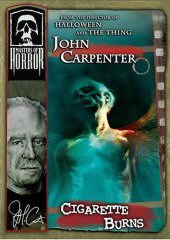
Stunning the cinematic world in 1978 with an approach to fear as devoted to the stylistic evocation of suggestion as it was to menacing atmosphere, John Carpenter's Halloween lent the lagging genre a primal simplicity and subversive fervour lacking in a field overpopulated by gothic European imagery and folklore-inspired themes. Carpenter instilled his deceivingly simplistic plot of carnal cat-and-mouse with a complex cultural sub-text, evoking a sense of paranoia, distrust, and the uncanny that was applicable to both the individual and society. In Cigarette Burns he achieves a similar success, finding terror hidden within both the confines of the everyday and in the outer metaphysical layers of the fantastic. The seemingly normal everyday and mythological nightmares are merged in this nihilistic, fascinating portrait of sin and redemption -- revealing, at the end, that there is little difference between bliss and damnation.
In a plot that combines the episodic structure of a detective mystery with occult formula, Cigarette Burns revolves around film programmer Kirby Sweetman's commission to track down a rare, supernatural canister of film for unscrupulous collector Ballinger. The film in question is La Fin Absolue du Monde, an obscure feature that gained legendary status for its reputed mind-altering effect, inspiring primal rage and excess, madness and Faustian knowledge. At its only screening at a festival decades ago, it sparked a riot and the print was thought destroyed. Kirby finds to his mounting horror that Ballinger has imprisoned an angel whose wings he has removed -- an artifact, of sorts, from the movie. The logic here suggests that if the film was truly destroyed than this being wouldn't still exist. Desperate for the money, Kirby puts his soul in danger for the cold, hard promise of cash. The script, penned by Drew McWeeney and Scott Swan, combines the awe-inspiring sentiment of Robert Chamber's thematically connected stories in The King in Yellow with a gritty modern realism. The result is a minor masterwork of surrealism whose suggestion of the power of art is disturbingly enticing and repulsive, mystical while somehow rooted in the horrors of the everyday. As Kirby experiences hallucinations brought on by seeing glimpses of the film, he can no longer tell the difference between reality and dream. Experiencing jarring moments of violence and outrage, he gets closer to his goal . . . and a profound emptiness as terrifying as it is subversively beautiful.
Lending intelligence, atmosphere, and relentless energy to an aesthetic form in danger of losing its emotional effectiveness and intelligence, Cigarette Burns inspires dread not so much through the art of violence as by the evocation of suspense. Carpenter injects emotional risk and terror through an interwoven tapestry of carefully depicted set pieces, asking us to invest sympathy in the characters as they unravel the secrets of a world where angels exist, personal visions subvert reality, and pain is a mystical certainty. Achieving awe when many filmmakers are content to merely repulse, Carpenter depicts in this admirable marriage of characterization and atmosphere a ballet of death and decadence. The horrific is made to look strangely attractive even as the familiar and comfortable is raped of meaning. Whether one regards the picture as a sensationalistic horror movie or as a scathing philosophical satire and/or condemnation of Hollywood and culture -- particularly the filmmaking process -- this story pleases. An impressive hybrid of various genre approaches, the grim violence of life stands alongside moments of pure fantasy, reaching subversive proportions in the scenes with the captured angel, suggesting an aura of tragic doomed grace that captures the philosophical complexity possible in this genre. More impressively, Carpenter and the writers dare ask: how much is too much? Is there a point at which filmmaking becomes terrorism? Who is responsible for one's actions, an artistic product or those viewing it? Exploring the trust we put in movie makers, and the role our own minds must play in defining the nature of reality, this is a horror film of ideas, daring to leave its hot-button questions unanswered.
Cigarette Burns is honored with yet another lavish DVD presentation by Anchor Bay, presented in widescreen (1.77:1) and enhanced for 16x9 television. As before, the colors are bold and vibrant, the flesh tones accurate, and no grain noticeable. Audio is just as pleasing, featured in Dolby Digital and Dolby Surround 2.0. In each the sound is crisp and clear, without distortion. Music by Cody Carpenter, the director's son, deserves special mention; his score is hauntingly ethereal, exploring new territories of dark enchantment.
Special features are a celebration of Carpenter's history as a filmmaker, and his influence on the genre. Included are interviews and features that celebrate the director's creative process, opinions on genre, and approach to the Cigarette Burns. The Audio Commentary is the disc's most satisfying piece, chock full of Carpenter's typical sardonic wit. He discusses the project's origins, how he prepared for the material, and offers various behind-the-scenes accounts. The other Commentary features Scott Swan and Drew McWeeny, writers which share some intriguing stories. These major supplements are reinforced and lent greater context by "Celluloid Apocalypse: An interview with John Carpenter" which covers material not included in the commentary. "Working with a Master: John Carpenter" includes interviews with FX maestro Greg Nicotero, Sam Neill, Keith Gordon, Julie Carmen, P. J. Soles, etc. Less exhaustive and more informal is the "On Set Interview with Norman Reedus" and a 4-minute "Making of Segment," perhaps the leanest addition. A Bio, Still Gallery, and plenty of DVD ROM goodies round out the DVD.
Review by William P. Simmons
| Released by Anchor Bay |
| Region 1 - NTSC |
| Not Rated |
| Extras : see main review |